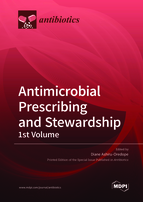Antimicrobial Prescribing and Stewardship, 1st Volume
A special issue of Antibiotics (ISSN 2079-6382). This special issue belongs to the section "Antibiotics Use and Antimicrobial Stewardship".
Deadline for manuscript submissions: closed (30 November 2020) | Viewed by 102775
Special Issue Editor
2. Commonwealth Pharmacists Association, London E1W 1AW, UK
Interests: antimicrobial resistance; antibiotics; antibiotic awareness; healthcare associated infection; antimicrobial stewardship; antimicrobial prescribing
Special Issues, Collections and Topics in MDPI journals
Special Issue Information
Dear Colleagues,
Antimicrobial Stewardship as “a coherent set of actions which promote using antimicrobials in ways that ensure sustainable access to effective therapy for all who need them” (Dyar, O.J.; 2017) is critical (alongside e.g. infection prevention and control strategies) for tackling antimicrobial resistance/drug resistant infections
The Antimicrobial Stewardship issue will consist of manuscripts, which may include original research, review articles, case series and opinion papers. Relevant antimicrobial (antibiotic, antifungal) stewardship related topics will be considered for review, specific areas of interest include:
- Novel methods to promote appropriate antibiotic utilization
- Disease-based/organism based antimicrobial stewardship
- Diagnostic stewardship
- Antifungal stewardship
- Influence of antimicrobial utilisation changes on antimicrobial resistance
- Impact of antimicrobial stewardship on quality performance measures and patient outcomes
- Novel antimicrobial stewardship education and training approaches or interventions aimed at the public and/or healthcare workers
- Behavioural change approaches to antimicrobial stewardship
- Review of specific controversial stewardship issues that have major impact on utilization, cost or resistance
- Collaborative practice agreements in antimicrobial stewardship
- Antimicrobial stewardship in special populations (e.g., paediatrics, geriatrics, emergency medicine, hematology/oncology)
- Tackling AMR through antimicrobial Stewardship in Low and Middle-income countries.
- Antimicrobial stewardship in alternative settings (e.g., community practice, long-term care, resource limited, small and rural hospitals)
- Risk-stratified approach to treating common infections in hospitalized patients
- Role of antimicrobial stewardship in managing medication shortages
- Building a business case/model for antimicrobial stewardship
The content for this edition aims to include articles that recognize the theme for World Antimicrobial Awareness Week 2020 - United to preserve antimicrobials” with articles showing the impact of global collaborations and health partnerships invited.
World Antimicrobial Awareness Week (WAAW), led globally by WHO, aims to increase awareness of global antimicrobial resistance (AMR) and to encourage best practices among the public, health workers and policy makers to avoid the further emergence and spread of drug-resistant infections.
Please see details in the following link: https://www.mdpi.com/journal/antibiotics/events/12496
Built on the success of this edition, a second volume on the "Antimicrobial Prescribing and Stewardship" has now been open for your submission and prescription. The new edition include new topics "Antimicrobial use and stewardship in the context of the COVID-19 pandemic" and "Global collaborations to tackle AMR through antimicrobial stewardshi".
see details at https://www.mdpi.com/journal/antibiotics/special_issues/Stewardship_2nd
Dr. Diane Ashiru-Oredope
Guest Editor
Manuscript Submission Information
Manuscripts should be submitted online at www.mdpi.com by registering and logging in to this website. Once you are registered, click here to go to the submission form. Manuscripts can be submitted until the deadline. All submissions that pass pre-check are peer-reviewed. Accepted papers will be published continuously in the journal (as soon as accepted) and will be listed together on the special issue website. Research articles, review articles as well as short communications are invited. For planned papers, a title and short abstract (about 100 words) can be sent to the Editorial Office for announcement on this website.
Submitted manuscripts should not have been published previously, nor be under consideration for publication elsewhere (except conference proceedings papers). All manuscripts are thoroughly refereed through a single-blind peer-review process. A guide for authors and other relevant information for submission of manuscripts is available on the Instructions for Authors page. Antibiotics is an international peer-reviewed open access monthly journal published by MDPI.
Please visit the Instructions for Authors page before submitting a manuscript. The Article Processing Charge (APC) for publication in this open access journal is 2900 CHF (Swiss Francs). Submitted papers should be well formatted and use good English. Authors may use MDPI's English editing service prior to publication or during author revisions.
Keywords
- Antibiotic utilization
- Diagnostic stewardship
- Antimicrobial stewardship education
- Antifungal stewardship
- Antimicrobial resistance
Related Special Issue
- Antimicrobial Prescribing and Stewardship, 2nd Volume in Antibiotics (25 articles)







